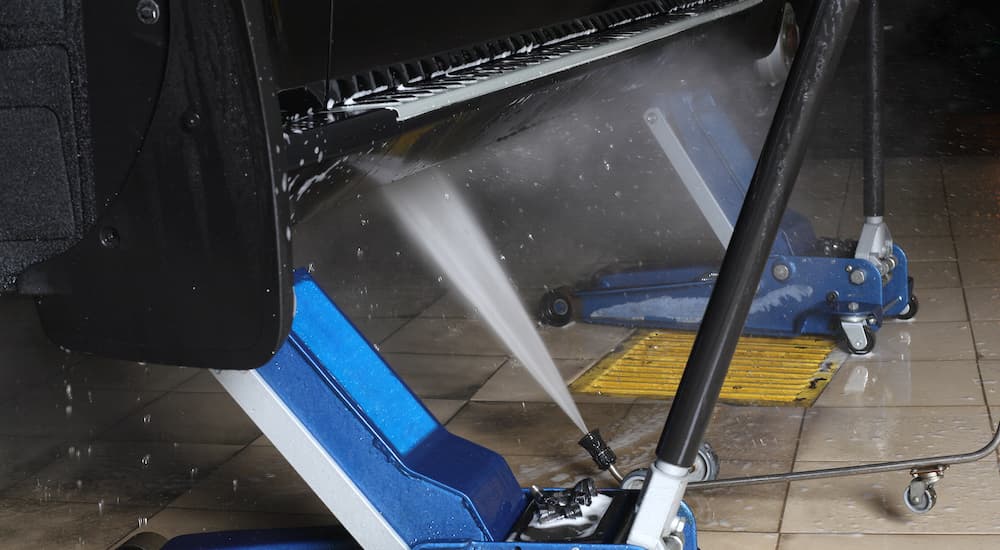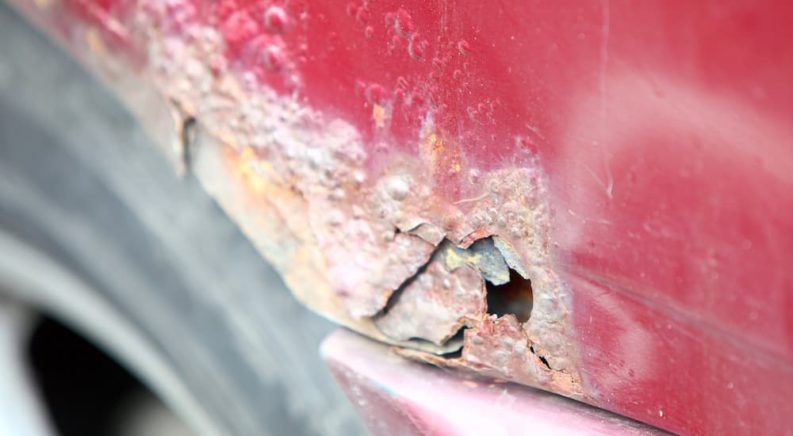For those living in colder climates, road salt is a necessary evil. While road or “rock” salt plays an important role in melting ice, providing traction, and keeping roads safe, it’s not without its drawbacks. While most drivers are eager to see their local road crews plowing snow and spreading road salt after a nasty winter storm, they often fail to consider the downside, namely, what can road salt do to your undercarriage. Contrary to popular belief, road salt doesn’t actually cause rust and corrosion, but it does dramatically speed up the process, turning a well-kept vehicle into a pitted, rusted mess in a relatively short time.
Drivers in colder areas are already facing an uphill battle when it comes to keeping their vehicles on the road. In addition to the rust-enhancing effects of road salt, colder temperatures can lead to shorter battery life and more wear and tear on the engine, as thicker oil impedes proper lubrication. The roads also tend to be worse in areas that experience harsh winters, as snowplows, frost heaves, and winter tires cause the asphalt to degrade at a faster rate. Given all these factors, it’s little surprise that vehicles operating in chillier climates tend to lack the longevity of their warm weather counterparts. Still, when it comes to road salt, there’s plenty that the average driver can do to mitigate its more harmful effects.
Rocky Road
Road salt has been used on American roads for almost 100 years, providing a safe way to combat slippery, icy roads. Salt has proven to be one of the easiest and most cost-effective ways to improve road safety, leading municipalities and Departments of Transportation to deploy over 20 million metric tons on the roads every year. That’s about 130 lbs of road salt for every American or 150 lbs for every car registered in the country. There’s no denying the effectiveness of road salt when it comes to safety and cost, but its corrosive effects can’t be discounted either.
How does road salt work? It all comes down to a relatively simple chemical reaction. When salt––scientifically known as sodium chloride––is spread over an icy surface, it dissolves into distinct sodium and chloride ions that attack the bonds between water molecules. As the dihydrogen monoxide (street name: water) bonds are compromised, the ice melts, and the presence of the sodium and chloride ions prevents it from reforming by effectively lowering the water’s freezing point. It’s an ingenious application of basic chemistry, but the same properties that make sodium chloride so effective when it comes to combating ice can also be a vehicle’s worst nightmare.
Left to its own devices, salt itself doesn’t actually present that much of a corrosion threat, but that all changes when water is introduced into the mix. Rust is almost inevitable when it comes to iron-rich metals like steel because when iron is introduced to water, it results in a chemical process of oxidation that creates good old iron oxide, aka rust. The melted salt-rich solution that pools on the road after salt is applied is rich with free-radical ions, accelerating the oxidation process and leading to rapid rusting.
There are also environmental factors to consider: widespread use of road salt can lead to drinking water contamination, endanger wildlife and even increase soil erosion. While there are some small-scale holistic alternatives like coffee grounds that might work for at-home applications like treating a walkway or driveway, we don’t see the local DOT teaming up with Starbucks to sprinkle the nation’s highways with used dark roast anytime soon. Like it or not, road salt is here to stay. That said, you can take some simple steps to mitigate the effects of road salt.
Combating Salt-Induced Rust
Rust will often first appear on some of the more exposed parts of your vehicle, such as the trunk, hood, and roof. These level, horizontal body panels provide the perfect surface for salt particles to accumulate, and while it might cause some cosmetic issues like fading or dullness, it’s not nearly as dangerous as what might be going on in your vehicle’s undercarriage. The undercarriage and wheel wells house some of the most vital components for safely operating, steering, and even stopping your vehicle. From brake calipers and brake lines to fuel lines, coil springs, and control arms, there are plenty of components ready to rust out without proper cleaning and maintenance. What’s a driver to do? Here are some simple tips for keeping corrosion at bay and keeping your vehicle on the road for as long as possible.

#1 – Avoid Snow
This tip seems almost too obvious to mention, but if you’re really looking to mitigate the effects of salt-induced corrosion, the easiest approach is just to avoid it altogether. Many drivers prefer to garage their nice cars during the winter, but you don’t have to go that far. Driving during or immediately after a big winter storm can lead to accelerated corrosion. As deep snow becomes packed into your vehicle’s undercarriage, it provides the perfect environment for rust to flourish by giving it all the moisture and salt it needs to eat through iron-rich components. Try to limit driving before the streets have been thoroughly cleared and remove any snow that’s adhered to the wheel wells or other areas before putting your vehicle away for the night.
#2 – Give Plow Trucks A Wide Berth
During a particularly heinous storm, it can be tempting to follow closely behind a plow truck, but this is a bad idea for a number of reasons. First, no one likes being tailgated, especially not someone behind the wheel of a ten-ton plow truck, but the salt factor is another important consideration. As the trucks clear the roads of snow and ice, they also spit out fresh road salt, which is all too ready to glom onto your vehicle and begin the corrosion process. Give these plow trucks, as well as other large vehicles like trucks, buses, and RVs, a wide berth, as they’re more likely to kick up the slushy snow/ice/salt mixture.
#3 – Steer Clear of Puddles
Puddle jumping is a great pastime for kids, but it starts to lose some of its appeal once you’re the one responsible for paying insurance and vehicle repairs. After salt has been applied to a road, puddles are usually brimming with the exact type of water and salt mixture that you’re trying to avoid. Steer clear of these rust-inducing landmines whenever possible, and if they’re too difficult to avoid, make sure not to skip the next step.
#4 – Wash the Undercarriage
Road salt is going to find its way into your vehicle’s undercarriage, it’s just a fact of life, but that doesn’t mean it’s there to stay. Many drivers tend to hang up their wash buckets and sponges over the winter, but regular cleaning is one of the easiest ways to mitigate the effects of road salt. Try to make a habit of cleaning your vehicle’s undercarriage every other week over the winter, preferably with a pressure washer that can really scrub out all the hard-to-reach nooks and crannies. Make sure the temperature is at least 40 degrees or higher to ensure the best possible results, and wash your car earlier in the day so it has time to dry before the sun sets and the temperature begins to drop. An automated car wash presents a convenient, if costly, alternative to the at-home approach, but no matter which method you prefer, don’t put this task off for any longer than necessary. Regular washing is particularly important in the week following a major storm when the roads are at their saltiest.

#5 – Wax and Rust-Proof
Never discount the importance of some additional undercarriage protection. Applying wax, rust-proofing, or other undercarriage treatments can make a big difference when protecting against corrosion, but it’s important to consider the timing. Wax treatments aren’t nearly as effective once the temperatures start to drop, so for best results, try to get it taken care of by mid-autumn at the latest (though a mid-winter touch-up can also be helpful). In general, you’ll want to reapply a wax coating every six months or so. Applying rust-proof undercoating is another worthwhile endeavor for drivers living in areas with particularly harsh winters.
Rust Never Sleeps
According to a study by the AAA, rock salt spread causes an estimated $3 billion in rust-related damage annually. It’s a necessary evil that ultimately goes a long way in improving road safety for drivers facing tough winter conditions, but it certainly has its drawbacks. “Rust Never Sleeps” is more than just a great folk-rock album; it’s a fact of life for every vehicle owner. While you can never completely eliminate the risks posed by rust, these simple tips will keep it at bay for as long as possible. From avoiding salt-laden roads and applying wax and other treatments to regular cleaning and changing your driving habits, keeping road salt from going to town on your vehicle’s iron-rich undercarriage is just a matter of simple maintenance.

